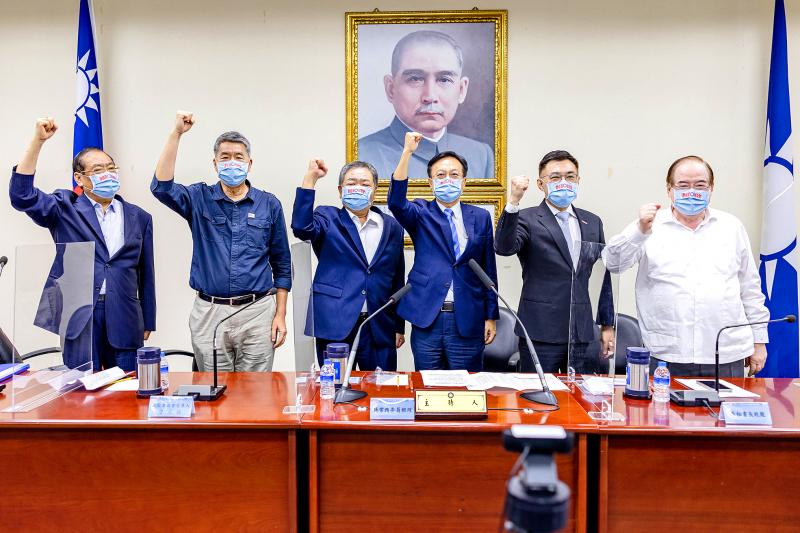Late last week the commentariat was stirred by a TVBS poll published on Thursday showing that pro-China dinosaur, college professor and fringe presidential contender Chang Ya-chung (張亞中) was leading establishment dinosaur Eric Chu (朱立倫) 30.6 percent to 27.5 percent in a poll of Chinese National Party (KMT) members. Current KMT Chairman Johnny Chiang (江啟臣), considered “youthful” at nearly 50, trailed with a dismal 12.8 percent.
TVBS is generally regarded as pro-KMT and so would have little reason to diddle the numbers, which show that Chu, the fair-haired boy of the party’s elites, has been in a slide since the beginning of last month, while Chang suddenly doubled his standing to leap past Chu. Polls are often used by voters to register disapproval and signal candidates. Once they get to the ballot box, they return to the reassuring arms of the establishment candidate.
FAR RIGHTISTS RULE

Photo: CNA
Chang, a far-right deep blue Mainlander — people who fled to Taiwan with the Chinese Nationalist Party (KMT) following its defeat in the Chinese Civil War — who advised far rightist Hung Hsiu-chu (洪秀柱) during her calamitous presidential campaign before the 2016 election, said in 2017 that he would never permit the KMT to become a Taiwanese KMT party. This attitude appeals to the deep blue senior citizens who now form the bulk of party members and internal voters of the KMT. It is wildly out of touch with mainstream opinion.
Even Beijing knows that.
Since the 2005 chairmanship election the KMT has been trapped by its far-right internal party electorate, which keeps putting forward rightists like Ma Ying-jeou (馬英九), Hung and Han Kuo-yu (韓國瑜). Ma, at least, knew how to grit his teeth and spit “I am Taiwanese” through them. Han possessed a thin veneer of populist appeal laid over his far-right pro-China views. Hung, a purist through and through, spurned the compromises of these lesser mortals.
The KMT has two roles — it must act like a political party and win elections, and yet, it must guard the spirit and identity of the Republic of China (ROC). Like the Catholic Church of old, it must simultaneously be in the world yet not of it. With the electorate almost completely pro-Taiwan, these roles are in deep contradiction.
The KMT electorate has chosen, in the last several elections, to give up the first role in favor of the second, at least at the national level. It can still win lower-level elections, in which its identity is not at stake. For now. But with its lack of youth and youth appeal, that will become increasingly difficult.
The 2005 KMT Chairmanship election pitted Wang Jin-pyng (王金平), the unofficial head of the Taiwanese KMT, against Mainlander Ma. Wang had the support of KMT elites and People’s First Party (PFP) head James Soong (宋楚瑜), who still had support within the KMT even after leaving it to start his own party. Despite this, Ma, supported by the party rank-and-file, won a crushing victory, 72 percent to 28 percent.
Looking back, the 2005 chairmanship election was likely the last chance the KMT had to Taiwanize itself as a major party with a powerful and widely respected Taiwanese politician at its helm.
Instead, that election crystalized the trends we now see in daily reports on the KMT — the older party members rejecting any Taiwanese candidate in favor of Mainlanders who are reliably rightist, the falling away of the young from the party and the declining power of the Taiwanese members of the KMT within the party.
It is interesting to review Wang’s subsequent moves. Is the current KMT mess in part the realization of Wang’s revenge?
SPLIT WITHIN THE PARTY
The 2005 chairmanship election brought to light the massive split in the KMT between the far rightists and centrist KMT politicians. By 2008 the KMT legislature was divided into the “Ma troop” who supported president Ma and the “southern legislators,” who were behind Wang.
In 2013 Ma attempted to boot Wang from the party over a wiretapping scandal. There were dark mutterings over that, because all three major KMT victims of that debacle were Taiwanese politicians.
When the Sunflower movement erupted in March 2014, occupying the legislature in protest over a hated trade deal with China, Wang piously refused to evict them using his powers as head of the Legislative Yuan, an embarrassment to Ma.
In 2015, Wang blocked a petition from Taiwanese KMT members to prevent far-rightist Hung from becoming the party’s presidential candidate at the critical July 19th party congress. Five legislators were expelled over their opposition to Hung. Many others simply left.
Wang, a canny politician widely respected in both camps for his skills as a broker, had to know that Hung couldn’t possibly win a presidential election, yet he did little about her candidacy.
Further, it was Wang who took Han under his wing, who had the local factions back Han in his rise to Kaohsiung mayor and thence to national prominence. It was obvious long before Han clinched the KMT nomination that he was a bog-standard Mainlander in his views on China and Taiwan and could never win the presidency. Understanding this, many on the pro-Taiwan side asked voters to support Han during the KMT candidacy election poll in July of 2019, a portion of which consisted of a poll of the public.
Wang had known Han for years. He had to know his political views. How could he not know that Han was dead on arrival as a presidential candidate?
The 2023 struggle for the KMT presidential nomination looms. Most of the contenders are members of the same tiresome clique of Mainlanders who have been on the KMT merry-go-round for the last decade or two, but there is one outstanding exception: New Taipei City Mayor Hou You-yi (侯友宜), probably the most popular mayor in Taiwan.
Hou is Taiwanese, conspicuous by his absence from the chairmanship election because he could not possibly win over an electorate that can give warm fuzzies to a far-right pro-China politico like Chang and rejects Taiwanese politicians. However, his popularity, and his Taiwanese, make him an ideal candidate for the KMT in the 2024 elections.
Which brings me to a question: what is Wang Jin-pyng’s attitude toward Hou You-yi?
Notes from Central Taiwan is a column written by long-term resident Michael Turton, who provides incisive commentary informed by three decades of living in and writing about his adoptive country. The views expressed here are his own.

The Taipei Times last week reported that the rising share of seniors in the population is reshaping the nation’s housing markets. According to data from the Ministry of the Interior, about 850,000 residences were occupied by elderly people in the first quarter, including 655,000 that housed only one resident. H&B Realty chief researcher Jessica Hsu (徐佳馨), quoted in the article, said that there is rising demand for elderly-friendly housing, including units with elevators, barrier-free layouts and proximity to healthcare services. Hsu and others cited in the article highlighted the changing family residential dynamics, as children no longer live with parents,

It is jarring how differently Taiwan’s politics is portrayed in the international press compared to the local Chinese-language press. Viewed from abroad, Taiwan is seen as a geopolitical hotspot, or “The Most Dangerous Place on Earth,” as the Economist once blazoned across their cover. Meanwhile, tasked with facing down those existential threats, Taiwan’s leaders are dying their hair pink. These include former president Tsai Ing-wen (蔡英文), Vice President Hsiao Bi-khim (蕭美琴) and Kaohsiung Mayor Chen Chi-mai (陳其邁), among others. They are demonstrating what big fans they are of South Korean K-pop sensations Blackpink ahead of their concerts this weekend in Kaohsiung.

Taiwan is one of the world’s greatest per-capita consumers of seafood. Whereas the average human is thought to eat around 20kg of seafood per year, each Taiwanese gets through 27kg to 35kg of ocean delicacies annually, depending on which source you find most credible. Given the ubiquity of dishes like oyster omelet (蚵仔煎) and milkfish soup (虱目魚湯), the higher estimate may well be correct. By global standards, let alone local consumption patterns, I’m not much of a seafood fan. It’s not just a matter of taste, although that’s part of it. What I’ve read about the environmental impact of the

Oct 20 to Oct 26 After a day of fighting, the Japanese Army’s Second Division was resting when a curious delegation of two Scotsmen and 19 Taiwanese approached their camp. It was Oct. 20, 1895, and the troops had reached Taiye Village (太爺庄) in today’s Hunei District (湖內), Kaohsiung, just 10km away from their final target of Tainan. Led by Presbyterian missionaries Thomas Barclay and Duncan Ferguson, the group informed the Japanese that resistance leader Liu Yung-fu (劉永福) had fled to China the previous night, leaving his Black Flag Army fighters behind and the city in chaos. On behalf of the